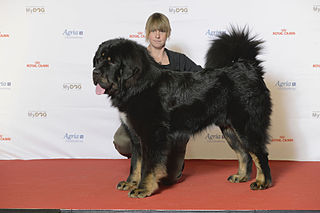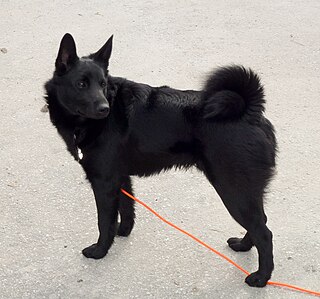
The Samoyed is a breed of medium-sized herding dogs with thick, white, double-layer coats. They are a spitz-type dog which takes its name from the Samoyedic peoples of Siberia. Descending from the Nenets Herding Laika, they are a domesticated animal that assists in herding, hunting, protection and sled-pulling.

The Swedish Vallhund, also known as the Västgötaspets and Swedish cow dog, is a breed of dog native to Sweden. The breed's name, Vallhund, when translated into English, means herding dog, as the Swedish Vallhund was originally bred as a drover and herder of cows over 1,000 years ago. In 1942, the dog came close to extinction, but careful breeding and publicity by Swedish national Björn von Rosen and K. G. Zettersten managed to revive the breed in popularity and save it from its likely end. In 1943, the Swedish Kennel Club recognized the Swedish Vallhund as a breed, and officially categorized the Swedish Vallhund as "the Västgötaspets" for Västergötland, the province in which their revival took place. Since then, the breed has been recognized by, and bred in, over ten countries and has gained some popularity.

The Jämthund, also called the Swedish Elkhound, is a breed of dog of the Spitz type that is found in Northern Europe. The Jämthund is eponymous with Jämtland, a province in the middle of Sweden.

The Saarloos Wolfdog is a wolf-dog breed originating from the Netherlands by the crossing of a German Shepherd with a Siberian grey wolf in 1935. The offspring were then further crossed with German Shepherds.

A wolfdog is a canine produced by the mating of a domestic dog with a gray wolf, eastern wolf, red wolf, or Ethiopian wolf to produce a hybrid.

The Greenland Dog is a large breed of husky-type dog kept as a sled dog. They were brought from Siberia to North America by the Thule people 1,000 years ago, along with the Canadian Eskimo Dog. The Canadian Eskimo Dog is considered the same breed as the Greenland Dog since they have not yet diverged enough genetically to be considered separate breeds, despite their geographic isolation.

The Norwegian Elkhound is one of the Northern Spitz-type breeds of dog and is the National Dog of Norway. The Elkhound has served as a hunter, guardian, herder, and defender. It is known for its courage in tracking and hunting elk and other large game, such as bears or wolves. The Norwegian Elkhound was first presented at a dog exhibition in Norway in 1877.

The Tibetan Mastiff is a large size Tibetan dog breed. Its double coat is medium to long, subject to climate, and found in a wide variety of colors, including solid black, black and tan, various shades of red and bluish-gray, and sometimes with white markings around neck, chest and legs.

The Carolina dog, also known as a yellow dog, yaller dog, American Dingo, or Dixie Dingo, is a breed of medium-sized dog occasionally found feral in the Southeastern United States, especially in isolated stretches of longleaf pines and cypress swamps. Efforts to establish them as a standardized breed has gained the Carolina Dog breed recognition in two smaller kennel clubs and full acceptance into the breed-establishment program of one major kennel club.
Canid hybrids are the result of interbreeding between the species of the genus Canis. This often occurs in the wild, and in particular between domestic or feral dogs with wild native canids.

The Finnish Lapphund –Finnish: Suomen Lapinkoira– is a hardy, easy going, medium-size breed of Spitz type. Traditionally it has been used for herding reindeer. Although it is one of the most popular dog breeds in its native country, Finland, it is not very numerous outside of the Nordic countries.

The domestication of the dog was the process which created the domestic dog. This included the dog's genetic divergence from the wolf, its domestication, and the emergence of the first dogs. Genetic studies show that all ancient and modern dogs share a common ancestry and descended from an ancient, now-extinct wolf population – or closely related wolf populations – which was distinct from the modern wolf lineage. The dog's similarity to the grey wolf is the result of substantial dog-into-wolf gene flow, with the modern grey wolf being the dog's nearest living relative. An extinct Late Pleistocene wolf may have been the ancestor of the dog.

The Lapponian Herder is a breed of dog from Finland, one of three Lapphund breeds developed from a type of dog used by the Sami people for herding and guarding their reindeer.

The Black Norwegian Elkhound is a small Spitz breed classified by the FCI as a hunting dog. It is currently an uncommon breed in Norway and very rare outside the Nordic countries of Scandinavia. It is a sibling breed to a Grey Norwegian Elkhound, but is smaller, more agile, doesn't bark and was bred explicitly for on-leash dog hunting.
Genetic studies on Sami is the genetic research that have been carried out on the Sami people. The Sami languages belong to the Uralic languages family of Eurasia.

In the taxonomic treatment presented in the third (2005) edition of Mammal Species of the World, Canis lupus dingo is a taxonomic rank that includes both the dingo that is native to Australia and the New Guinea singing dog that is native to the New Guinea Highlands. It also includes some extinct dogs that were once found in coastal Papua New Guinea and the island of Java in the Indonesian Archipelago. In this treatment it is a subspecies of Canis lupus, the wolf, although other treatments consider the dog as a full species, with the dingo and its relatives either as a subspecies of the dog, a species in its own right, or simply as an unnamed variant or genetic clade within the larger population of dogs. The genetic evidence indicates that the dingo clade originated from East Asian domestic dogs and was introduced through the Malay Archipelago into Australia, with a common ancestry between the Australian dingo and the New Guinea singing dog. The New Guinea singing dog is genetically closer to those dingoes that live in southeastern Australia than to those that live in the northwest.

A jackal–dog hybrid is a canid hybrid resulting from a mating between a domestic dog and a golden jackal. Such crossbreeding has occurred numerous times in captivity and was first confirmed to occasionally happen in the wild in Croatia in 2015.

Hällefors Elkhound is a Swedish dog breed.

The cave wolf is an extinct subspecies of wolf that lived during the Late Pleistocene Ice Age. It inhabited what is now modern-day western Europe. The Don wolf from eastern Europe is regarded as a taxonomic synonym, which indicates that one subspecies once lived across Europe.

The evolution of the wolf occurred over a geologic time scale of at least 300 thousand years. The grey wolf Canis lupus is a highly adaptable species that is able to exist in a range of environments and which possesses a wide distribution across the Holarctic. Studies of modern grey wolves have identified distinct sub-populations that live in close proximity to each other. This variation in sub-populations is closely linked to differences in habitat – precipitation, temperature, vegetation, and prey specialization – which affect cranio-dental plasticity.


















